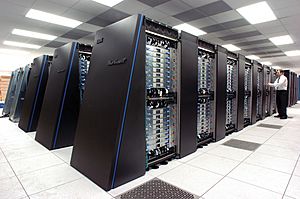Parallel computing facts for kids
Parallel computing is a way that computers solve big problems by breaking them into many smaller parts. These smaller parts are then worked on at the same time, or "in parallel." Imagine a team of people working on different parts of a big puzzle all at once instead of one person doing it alone. This makes the work finish much faster!
This method has been used for many years, especially in powerful supercomputers. Its use has grown a lot recently. This is because regular computer chips can't get much faster by just increasing their "clock speed" (how many calculations they do per second). So, to make computers more powerful, we now add more "brains" or processing parts that work together. This is why most modern computers, like your phone or laptop, have multi-core processors.
Contents
How Parallel Computing Works
Parallel computing helps computers do many things at once. Instead of doing tasks one after another, they do them side-by-side. This is like having multiple workers instead of just one.
Types of Parallelism
There are different ways computers can work in parallel:
- Bit-level parallelism: This is about how many bits (tiny pieces of data) a computer can process at once. Older computers processed 8 bits, then 16, then 32, and now often 64 bits at a time. More bits mean more data handled faster.
- Instruction-level parallelism: This is when a computer's main brain (the CPU) can do several steps of different instructions at the same time. It's like an assembly line where different parts of a product are being worked on simultaneously.
- Data parallelism: This happens when the same task is done on many different pieces of data at the same time. For example, if you have a huge list of numbers and you need to add 1 to each one, a parallel computer could add 1 to many numbers at once.
- Task parallelism: This is when different tasks are done at the same time. For instance, one part of the computer might be handling graphics while another part is running the game's artificial intelligence.
Different Parallel Computers
Parallel computers come in many forms, depending on how their parts work together:
- Multi-core processors: These are common in everyday devices. A single computer chip has multiple "cores" or processing units. Each core can work on a different part of a problem.
- Multi-processor computers: These are similar to multi-core but might have several separate chips, each with its own processor, all working together in one machine.
- Clusters: Imagine many separate computers connected together to act like one big supercomputer. They share the work to solve a huge problem.
- Grids: This is an even bigger network of computers, often spread across different locations, all connected to solve a single, very large problem. Think of it like a global team effort.
Challenges in Parallel Computing
Even though parallel computing makes things faster, it's not always easy to program.
- Programming difficulty: Writing programs for parallel computers is harder than for regular ones. You have to make sure all the different parts of the computer work together smoothly.
- Communication and synchronization: The different parts of a parallel computer need to talk to each other and stay in sync. If they don't, they might get confused or make mistakes.
- Software bugs: New kinds of errors can happen in parallel programs. For example, a "race condition" is when two parts of the computer try to change the same data at the exact same time, leading to unexpected results. A "deadlock" is when different parts of the computer are all waiting for each other, and nothing gets done.
Despite these challenges, many special programming languages and tools have been created to make it easier to write programs for parallel computers.
Images for kids
-
A cabinet from IBM's Blue Gene/L massively parallel supercomputer.
See also
 In Spanish: Computación paralela para niños
In Spanish: Computación paralela para niños








